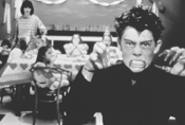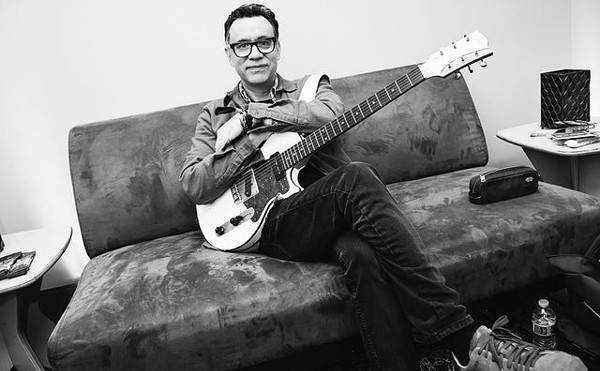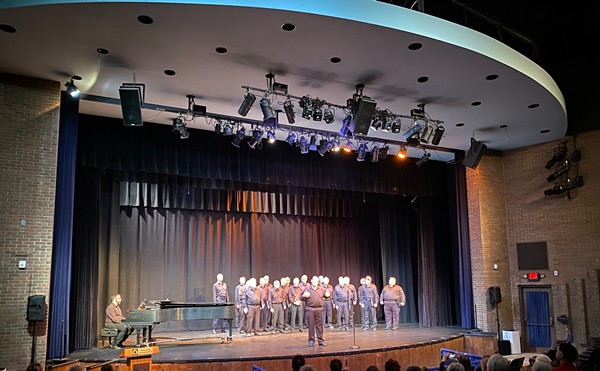At the age of 49, Nicosia can already look back on 20 years of artistic productivity. The Dallas native first came to national attention in the early '80s when, along with conceptual artists like Cindy Sherman, Sarah Charlesworth, and Jeff Wall, he advanced the then controversial (even radical) notion that painting could no longer serve as a suitable vehicle for contemporary artistic expression and that photography and video would have to fill that void. But not just any photography or video. According to these pioneers, documentary picture-taking, for example, is not the way to replace painting. Such photography has a truth-telling function. When you see one of the sharecroppers in Walker Evans's Depression-era photos, for instance, you think of Edward Weston's eye for composition and his humanity but, perhaps above all, you think about his subjects, those hollow-eyed people who endured so much suffering.
Nicosia is not interested in finding subjects; he's interested in creating them. What does this mean in practice? The artist insists on control over the scenes that he chooses to depict; in short, he assumes the role of director. Not a Robert Flaherty (who, in a 1922 film, eloquently told the true story of a group of Eskimos from their point of view) but rather an Alfred Hitchcock, who storyboarded every camera set-up in advance and boasted that the actual process of filming a scene was boring to him, because he had already done the creative work. By choosing his subject matter and exerting control over every aspect of staging, lighting, and editing, Nicosia emphasizes his own view. Be careful, though, before you accuse Nicosia (or Hitchcock, for that matter) of being dishonest. The Nicosia show recalls Pablo Picasso's definition of art as a lie that helps us see the truth.
As a retrospective, the exhibit is well-balanced. This, the first major survey of Nicosia's work, includes selections from nine series of narrative photographs and four recent works in film and video. There are selections from the early '80s -- whimsical scenes of colorful storefronts, mailboxes, and domestic interiors that the artist created in his studio and then photographed. The artist notes that in such works he never moved his camera. He simply constructed the set and shot this carefully manipulated environment from a fixed position in his studio. This is experimental art that emphasizes the essential flatness of the image and, in general, encourages the viewer to remember that everything about it -- including the "mailboxes" and "television sets" made from colorful construction paper -- are fake. This early work is interesting mostly for how it paves the way for Nicosia's later photography. It seems like a collection of devices -- a series of expressive tics, or twitches of creative energy. These early pieces take artificiality as the goal, rather than as a starting point.
The later work is less agenda-driven, and it's also stronger. If the self-consciousness in the early pieces seems crippling, Nicosia gradually mixes his theoretical games with the raw experiences of the street and the suburban living room. A case in point is "Untitled (Sam)," a 1986 photograph from his "Life as We Know it" series. The scene is fake -- it's been constructed in the artist's studio -- but it resonates far beyond its artificial origins. It shows a suburban birthday party. At left, in soft focus, some kids are sitting at a table covered with a tablecloth decorated with red hearts. On the right-hand side of the frame, in the foreground, is an image of what could be the birthday boy himself. He's dressed up like Count Dracula -- black outfit, plastic vampire teeth, and plastic red fingernails that jut outward like claws. This elementary-school vampire stares out at us with a grim expression -- he's playing his part well, a real Bela Lugosi in the making. What is Nicosia getting at here? He's taking a normal suburban scene and he's altering it, thus exposing violent undercurrents that threaten the peaceful façade of middle-class America.
The sole adult figure in the shot is relegated to the background, and she's blurry. The young vampire-in-training is the center of this universe. His aggression is the focus of the shot, and so strong is it that he has displaced adult authority. Remember the Twilight Zone episode about the six-year-old who could read minds and make adults do his bidding? If he didn't like some people he could simply "wish them away to the cornfield." Nicosia's kid is frightening in that way. The power balance has shifted, and his unpredictable aggressive urges threaten to turn this birthday gathering into a nightmare.
Also forceful and disturbing (and from the same series) is "Violence." This one shows a staged cocktail party. A woman holds a glass of white wine, while another smiles at far right. A gray-haired executive wearing cowboy boots scowls as he watches a man in a dark blue suit punching a similarly dressed man in the stomach. The photograph recalls the well-known image of Lee Harvey Oswald grimacing as Jack Ruby shoots him: In that shot, too, there is a moment of sudden violence that has one person writhing in pain while most of the crowd is unaware of what, exactly, is taking place. Nicosia is here doing an interesting thing. He seems to be alerting us to the notion that even real events -- like the Oswald shooting -- can look as artificial and staged as this violent scene concocted entirely in the artist's studio. Like the German playwright Bertolt Brecht who, during the 1920s, aspired to distance his audience from the events on the stage so that they could view them critically, Nicosia appears to be encouraging his audience to step back and wonder about events like the Oswald shooting. Was that staged, as well? Nicosia is not rewriting history, unlike Oliver Stone. He wants us to think about violence, to question the commonly accepted versions of events. "Violence" is subtle work that engages the viewer's attention on many levels simultaneously. It's one of the highlights of the show.
Also eerie and effective is Nicosia's 1997 black-and-white video, "Middletown." This 13-minute exercise is simplicity itself, or so it seems. In one long continuous shot, Nicosia treks through a Dallas suburban neighborhood. The camera's steady forward progress is interrupted momentarily by a person on stilts, an old man, some kids. Along the tree-lined avenue we see people watering their lawns, some motorists attending to a smoking automobile hood, and a couple of businessmen wearing Stetsons. All is thrown off kilter because the music, a waltz-like circus tune reminiscent of the scores in the films of Federico Fellini and François Truffaut, interacts oddly with the visuals. With this musical underscoring, these mundane scenes are given a hint of sadness and strangeness. "Middletown's" composers, Ernie Meyers and Steve Powell, invest these innocuous events with pathos. One recalls the last scene of Truffaut's 1961 film Jules and Jim, in which the hero follows the caskets of his friend and wife (who had just committed suicide together). Georges Delerue, the composer, wrote a jaunty, Satie-esque tune, which, instead of alleviating the sorrow of the scene, actually intensifies it. Like Truffaut's scene, Nicosia's video demonstrates how a filmmaker can add new layers of meaning to his work when score and visuals seem to say opposing things.
This is a strong retrospective. When Nicosia zooms in on the strange birthday party, the cocktail hour gone awry, or a sad and quirky suburban scene, he isolates these grimly comic moments for us and asks us to wonder anew about ominous undercurrents that threaten to break through the veneer of contemporary American suburbia.












